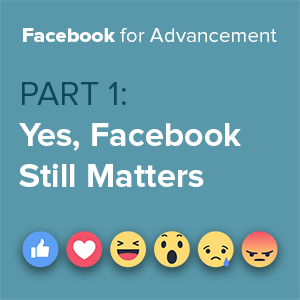In this Facebook for Advancement series we’re taking a look at the world’s biggest social media platform and how (and why) advancement offices can take advantage of all it has to offer. Because it offers a lot. To kick things off, today we’re diving into why Facebook still matters.
Let’s just get this out of the way right at the start: Facebook is still an incredibly powerful tool for your fundraising efforts. We’re guessing many (most? all?) of you reading this are thinking, “Facebook is declining, so why waste my time and energy on a dying platform?”
Sure, Facebook has been around since the dawn of internet (or at least that’s how it feels). And, yes, it has more competition for people’s attention than ever before.
But there are lots of reasons it’s still worth putting in the effort. 68 of them, to be exact. That’s because 68% of U.S. adults use Facebook. By comparison, Twitter (24%), LinkedIn (25), Snapchat (27), Pinterest (29), and Instagram (35) are all well behind that mark.
Of those users, 74% check Facebook every single day. Think of all the things people should do every day, but don’t. You know they don’t? They’re probably checking Facebook.
But What About the Young Folks?
Facebook is still dominating, but that doesn’t mean we’re going to sit here and say what you’ve heard is completely unfounded. Younger users are increasingly showing a preference for Instagram over Facebook.
But you know who owns Instagram? Facebook. And you know what ad network Instagram uses? Facebook’s.
That’s why it’s important to remember that Facebook isn’t just Facebook. Aside from Instagram, it also includes Facebook Messenger and WhatsApp. Collectively they reach billions of people each and every month. That’s a lot of eyeballs. Ignore them at your own risk.
And while 18-24 year olds are migrating to Instagram, you know who continues to adopt Facebook? Older generations, who, conveniently, are the exact people you’re likely targeting for mid and major-level gifts.
If Everyone Still Uses Facebook, What Are They Giving Up?
Not only does Facebook reach your alumni in a place they’re already spending time, a lot of its features are completely free of charge.
The same can’t be said of your emails, alumni magazines, phonathons, and in-person visits. All of which are showing declining effectiveness.
~70% of nonprofit/education email goes unread. Magazine sales are down 60% since 2007. Phonathon donors have declined 21% in the last 5 years. 44% of people would rather communicate with people they don’t know via social networks.
Think of how much effort and money you pour into these traditional channels. To what end? Since 2005, alumni participation rates have dropped by 33%. Since 1990, they’ve been cut fully in half.
So, should you abandon those classics completely? Certainly not. We’re not trying to paint a picture of a doomsday scenario. But it is time to start shifting some of those resources to Facebook and other social channels.
Is Any of This Important for Advancement?
Is it ever. Social flat out works. We’ve seen it for ourselves.
We’ve recorded 50 million interactions with institutions and mapped each of them directly back to a constituent’s record for use in future segmentation and outreach. In doing so we discovered a few trends.
The average school has 300,000 Facebook interactions on average. That’s a lot of data about your constituents to have at our fingertips. And roughly 9% of connected alumni ONLY interact with their alma mater digitally.
But a quick like is pretty impersonal, right? That couldn’t possibly lead to a donation, could it? In actuality, participation among digitally engaged constituents is 3.4x higher than average. And gift likelihood increases with each new Facebook interaction.
That doesn’t add up to a bunch of $5 gifts, either. Donors who contribute above their institutions average lifetime gift amount are twice as likely to interact with the organization on Facebook.
But 43% of the average institution’s high-capacity, digitally-engaged donors remain unassigned. Yikes.
Not only are these donors out there…they’re hiding in plain sight in the threads of your latest Facebook posts. It’s a matter of whether or not you’re paying attention.
OK, so now you’re convinced that you need to commit to Facebook. Well, if we did this right you are anyway. But…what exactly do you put on there? How do you capitalize on that audience? We’ll tackle that on Thursday when we get into creating content specifically for Facebook, so check back soon.

